Feasibility of Moderate Deficit Irrigation as a Water Conservation Tool in California’s Low Desert Alfalfa
Abstract
1. Introduction
2. Materials and Methods
2.1. Field Experiments
2.2. ET Monitoring and Data Processing
2.3. Canopy Temperature and Soil Moisture Monitoring
2.4. Soil Salinity Assessment
2.5. Yield Measurements and Plant Stand Evaluation
2.6. Water Productivity
2.7. Statistical Analysis
3. Results
3.1. Weather Parameters
3.2. Applied Water
3.3. Soil Moisture Status and Crop Water Stress
3.4. Actual Evapotranspiration and Crop Coefficients
3.5. Soil Salinity and Water Availability Features
3.6. Alfalfa Yield Responses
3.7. Forage Quality
3.8. Water Conservation Versus Yield Reduction
4. Discussion
5. Conclusions
- The ET and crop coefficient values reported herein are referred to as observed or actual values, which are limited by water deficits and salinity, and the ‘dry down’ required for frequent harvests. The maximum crop ET (ETc) is limited only by energy availability to vaporize water and not soil hydrology or salinity, or droughts imposed by harvest scheduling. Imposed stress, such as this, is common to almost all alfalfa growing regions.
- Although stand density under desert conditions decays more rapidly than other locations, there were negligible differences between different deficit irrigation strategies and normal farmers’ irrigation practices in this study after one year of water deficits. However, it is uncertain whether multiple years of summer irrigation strategies might threaten the long-term viability of the crop stand and yields.
- Although, it might be unlikely to prevent salinity buildup due to summer water deficits, salinity issues are likely to be managed through irrigation practices that flush salts in the months after implementing deficit irrigations. Continuous monitoring of soil salinity is recommended to ensure flushing/leaching salts out of root zone over multiple deficit irrigation seasons.
- The importance of re-filling of the soil profile with water, in the year after implementing summer irrigation strategies, need to be considered both in terms of water availability, crop production, and policy. Such practices might enable shifting water demand to water-rich time periods in early spring. This practice would benefit both early season growth and salinity management in subsequent years. In this study, continuous soil moisture readings verified that soil moisture was insignificantly depleted in the deficit irrigation fields. However, data from multiple irrigation seasons are required to fully certify this conclusion.
- Implementation of the proposed summer deficit irrigation strategies on alfalfa could provide a reliable source of seasonally available water as well as sustain the economic viability of agriculture in the region. These strategies might be sustainable as an effective water conservation tool if such measures provide adequate economic incentives to the participating farmers. Incentive programs to farmers must offset the risk of implementing the proposed practices (even trivial production loss), as a tool for adopting water conservation practices.
Author Contributions
Funding
Acknowledgments
Conflicts of Interest
References
- Montazar, A. Update alfalfa crop water use information: An estimation for spring and summer harvest cycles in California low desert. Agric. Briefs-Imp. Cty. 2019, 22, 202–205. [Google Scholar]
- Montazar, A. Deficit Irrigation Program Study. In Proceedings of the Law of Colorado River Conference, Scottsdale, AZ, USA, 12–13 March 2020. [Google Scholar]
- Hanson, B.; Putnam, D.; Snyder, R. Deficit irrigation of alfalfa as a strategy for providing water for water-short areas. Agric. Water Manag. 2007, 93, 73–80. [Google Scholar] [CrossRef]
- Orloff, S.; Hanson, B. Conserving water through deficit irrigation of alfalfa in the intermountain area of California. Forage Grazing Lands 2008. [Google Scholar] [CrossRef]
- Orloff, S.; Putnam, D.; Bali, K. Drought Strategies for Alfalfa; ANR Publication no. 8522; University of California: Oakland, CA, USA, 2015. [Google Scholar]
- Montazar, A.; Radawich, J.; Zaccaria, D.; Bali, K.; Putnam, D. Increasing water use efficiency in alfalfa production through deficit irrigation strategies under subsurface drip irrigation. Water shortage and drought: From challenges to solution. In Proceedings of the USCID Water Management Conference, San Diego, CA, USA, 17–20 May 2016. [Google Scholar]
- Montazar, A. Partial—Season Irrigation as an Effective Water Management Strategy in Alfalfa. Agric. Briefs 2017, 10, 3–7. [Google Scholar]
- Peterson, P.R.; Sheaffer, C.C.; Hall, M.H. Drought Effects on Perennial Forage Legume Yield and Quality. Agron. J. 1992, 84, 774–779. [Google Scholar] [CrossRef]
- Kirkham, M.B.; Johnson, D.E.; Kanemasu, E.T.; Stone, L.R. Canopy temperature and growth of differentially irrigated alfalfa. Agric. Meteorol. 1983, 19, 235–246. [Google Scholar] [CrossRef]
- Grimes, D.W.; Wiley, P.L.; Sheesley, W.R. Alfalfa yield and plant water relations with variable irrigation. Crop Sci. 1992, 32, 1381–1387. [Google Scholar] [CrossRef]
- Asseng, S.; Hsiao, T. Canopy Co2 assimilation, energy balance, and water use efficiency of an alfalfa crop before and after cutting. Field Crops Res. 2000, 67, 191–206. [Google Scholar] [CrossRef]
- Orloff, S.; Putnam, D.; Bali, K.; Hanson, B.; Carlson, H. Implications of deficit irrigation management on alfalfa. In Proceedings of the California Alfalfa and Forage Symposium, Visalia, CA, USA, 12–14 December 2005. [Google Scholar]
- Ottman, M. Irrigation cutoffs with alfalfa-what are the implications? In Proceedings of the 2011 Western Alfalfa and Forage Conference, Las Vegas, NV, USA, 11–13 December 2011. [Google Scholar]
- Sheaffer, C.C.; Tanner, C.B.; Kirkham, M.B. Alfalfa water relations and irrigation. In Alfalfa and Alfalfa Improvement; Hanson, A.A., Barnes, D.K., Hill, R.R., Eds.; Agronomy Monographs, ASA-CSSA-SSSA; The American Society of Agronomy: Madison, WI, USA, 1988; Volume 29, pp. 373–409. [Google Scholar]
- Ottman, M.J.; Tickes, B.R.; Roth, R.L. Alfalfa yield and stand response to irrigation termination in an arid environment. Agron. J. 1996, 88, 44–48. [Google Scholar] [CrossRef]
- Frate, C.A.; Roberts, B.A.; Marble, V.L. Imposed drought stress has no long-term effect on established alfalfa. Calif. Agric. 1991, 45, 33–36. [Google Scholar] [CrossRef]
- Robinson, F.E.; Teuber, L.R.; Gibbs, L.K. Alfalfa Water Stress Management During Summer in Imperial Valley for Water Conservation; Research Report; Desert Research and Extension Center: El Centro, CA, USA, 1994. [Google Scholar]
- Putnam, D.; Takele, E.; Kallenback, R.; Graves, W. Irrigating Alfalfa in the Low Desert: Can Summer Dry-Down be Effective for Saving Water in Alfalfa? United States Bureau of Reclamation: Washington, DC, USA, 2000.
- Cabot, P.; Brummer, J.; Hansen, N. Benefits and impacts of partial season irrigation on alfalfa production. In Proceedings of the 2017 Western Alfalfa and Forage Conference, Reno, NV, USA, 28–30 November 2017. [Google Scholar]
- Guitjens, J.C. Alfalfa irrigation during drought. J. Irrig. Drain. Eng. 1993, 119, 1092–1098. [Google Scholar] [CrossRef]
- Lamm, F.L.; Harmoney, K.R.; Aboukheira, A.A.; Johnson, S.K. Alfalfa production with subsurface drip irrigation in the Central Great Plains. Trans. ASABE 2012, 55, 1203–1212. [Google Scholar] [CrossRef]
- Irmak, S.; Odhiambo, L.O.; Kranz, W.L.; Eisenhauer, D.E. Irrigation Efficiency and Uniformity, and Crop Water Use Efficiency; Extension Circular EC732; University of Nebraska-Lincoln: Lincoln, NE, USA, 2011. [Google Scholar]
- Snyder, R.L.; Spano, D.; Pawu, K.T. Surface Renewal analysis for sensible and latent heat flux density. Bound. Layer Meteorol. 1996, 77, 249–266. [Google Scholar] [CrossRef]
- Shaw, R.H.; Snyder, R.L. Evaporation and eddy covariance. In Encyclopedia of Water Science; Stewart, B.A., Howell, T., Eds.; Marcel Dekker: New York, NY, USA, 2003. [Google Scholar]
- Paw, U.K.T.; Snyder, R.L.; Spano, D.; Su, H.-B. Surface renewal estimates of scalar exchange. In Micrometeorology in Agricultural Systems; Hatfield, J.L., Baker, J.M., Eds.; Agronomy Society of America: Madison, WI, USA, 2005; pp. 455–483. [Google Scholar]
- Montazar, A.; Rejmanek, H.; Tindula, G.N.; Little, C.; Shapland, T.M.; Anderson, F.E.; Inglese, G.; Mutters, R.G.; Linquist, B.; Greer, C.A.; et al. Crop coefficient curve for paddy rice from residual of the energy balance calculations. J. Irrig. Drain. Eng. 2017, 143, 04016076. [Google Scholar] [CrossRef]
- Shapland, T.M.; McElrone, A.J.; Paw, U.K.T.; Snyder, R.L. A turnkey data logger program for field-scale energy flux density measurements using eddy covariance and surface renewal. Ital. J. Agrometeorol. 2013, 1, 1–9. [Google Scholar]
- Snyder, R.L.; Pedras, C.; Montazar, A.; Henry, J.M.; Ackley, D.A. Advances in ET-based landscape irrigation management. Agric. Water Manag. 2015, 147, 187–197. [Google Scholar] [CrossRef]
- Montazar, A.; Krueger, R.; Corwin, D.; Pourreza, A.; Little, C.; Rios, S.; Snyder, R.L. Determination of Actual Evapotranspiration and Crop Coefficients of California Date Palms Using the Residual of Energy Balance Approach. Water 2020, 12, 2253. [Google Scholar] [CrossRef]
- Twine, T.E.; Kustas, W.P.; Norman, J.M.; Cook, D.R.; Houser, P.R.; Meyers, T.P.; Prueger, J.H.; Starks, P.J.; Wesely, M.L. Correcting eddy-covariance flux underestimates over a grassland. Agric. Forest Meteorol. 2000, 103, 279–300. [Google Scholar] [CrossRef]
- CIMIS. Available online: http://wwwcimis.water.ca.gov/SpatialData.aspx (accessed on 7 September 2020).
- Idso, S.B.; Jackson, R.D.; Pinter, P.J., Jr.; Reginato, R.J.; Hatfield, J.L. Normalizing the stress-degree-day parameter for environmental variability. Agric. Meteorol. 1981, 24, 45–55. [Google Scholar] [CrossRef]
- Corwin, D.L.; Lesch, S.M. Application of soil electrical conductivity to precision agriculture: Theory, principles, and guidelines. Agron. J. 2003, 95, 455–471. [Google Scholar] [CrossRef]
- Corwin, D.L.; Lesch, S.M. Characterizing soil spatial variability with apparent soil electrical conductivity: I. Survey protocols. Comput. Electron. Agric. 2005, 46, 103–133. [Google Scholar] [CrossRef]
- Corwin, D.L.; Lesch, S.M. Apparent soil electrical conductivity measurements in agriculture. Comput. Electron. Agric. 2005, 46, 11–43. [Google Scholar] [CrossRef]
- Corwin, D.L.; Scudiero, E. Field-scale apparent soil electrical conductivity. In Methods of Soil Analysis; Logsdon, S., Ed.; Soil Science Society of America: Madison, WI, USA, 2016; Volume 1. [Google Scholar]
- Norris, K.H.; Barnes, R.F.; Moore, J.E.; Shenk, J.S. Predicting forage quality by near infrared reflectance spectroscopy. J. Anim. Sci. 1976, 43, 889–897. [Google Scholar] [CrossRef]
- Doorenbos, J.; Kassam, A.H. Yield response to water. In FAO Irrigation and Drainage Paper 66; FAO: Rome, Italy, 1979; p. 193. [Google Scholar]
- Kuslu, Y.; Sahin, U.; Tunc, T.; Kiziloglu, F.M. Determining water-yield relationship, water use efficiency, seasonal crop and pan coefficient for alfalfa in as semiarid region with high altitude. Bulg. J. Agric. Sci. 2010, 16, 482–492. [Google Scholar]
- Jones, L.P. Agronomic Responses of Grass and Alfalfa Hayfields to No and Partial Season Irrigation as Part of a Western Slope waTer Bank. Master’s Thesis, Colorado State University, Fort Collins, CO, USA, 2015. [Google Scholar]
- Putnam, D.H.; Ottman, M.J. Your Alfalfa Crop Got the Blues? It May be ‘Summer Slump’; Cooperative Extension; University of California: Half Moon Bay, CA, USA, 2013. [Google Scholar]
- Ayers, R.S.; Westcott, D.W. Water Quality for Agriculture. In FAO Irrigation and Drainage Paper No. 29; FAO: Rome, Italy, 1985; p. 174. [Google Scholar]
- Putnam, D.; Benes, S.; Galdi, G.; Hutmacher, B.; Grattan, S. Alfalfa (Medicago sativa L.) is tolerant to higher levels of salinity than previous guidelines indicated: Implications of field and greenhouse studies. In Proceedings of the 19th EGU General Assembly, Vienna, Austria, 23–28 April 2017. [Google Scholar]
- U.S. Department of Agriculture. Farm and Ranch Irrigation Survey, 2012. In Census of Agriculture; USDA: Washington, DC, USA, 2014; Volume 3. [Google Scholar]
- Montazar, A.; Putnam, D.; Bali, K.; Zaccaria, D. A model to assess the economic viability of alfalfa production under subsurface Drip Irrigation in California. Irrig. Drain. 2017. [Google Scholar] [CrossRef]
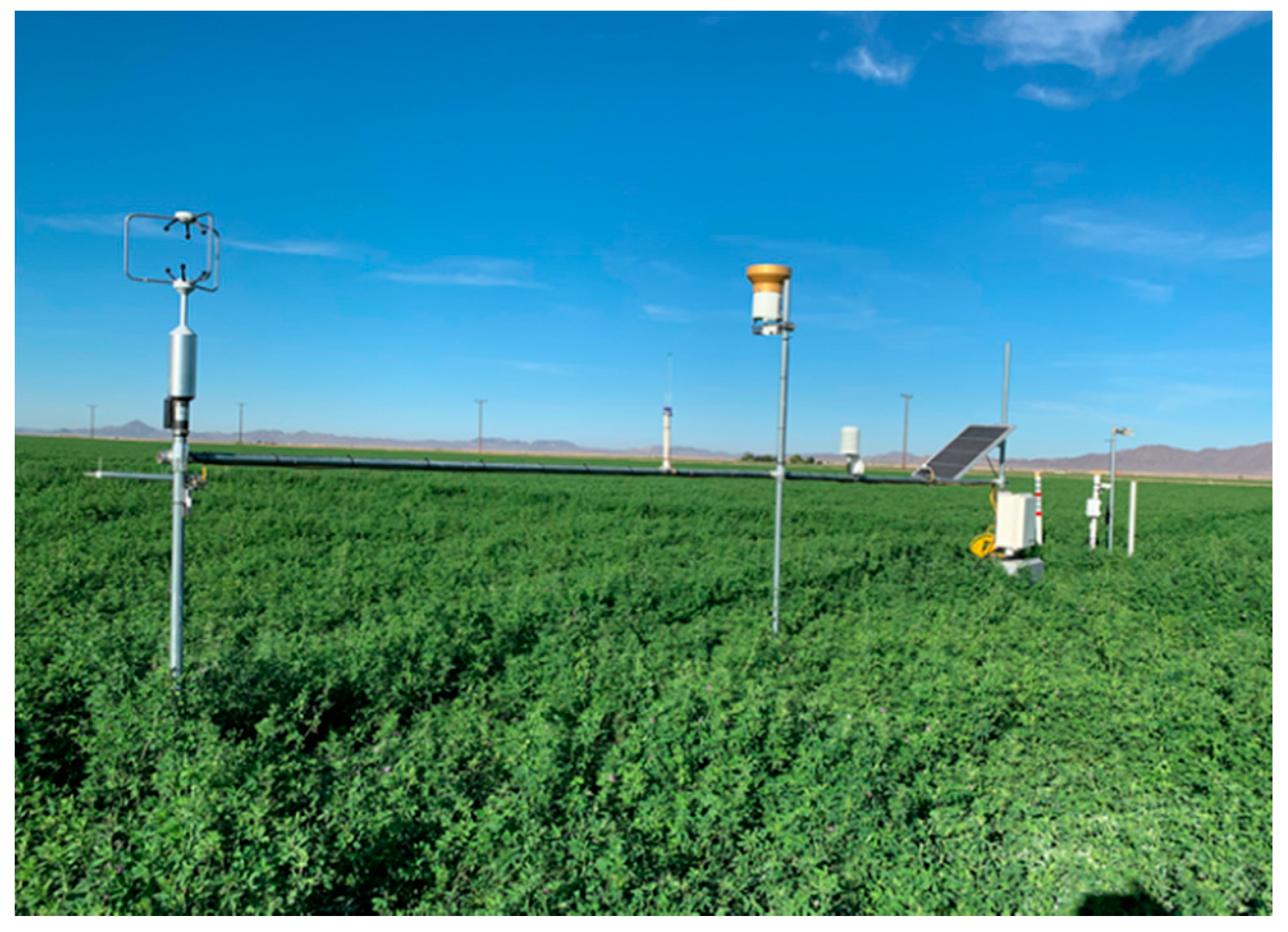
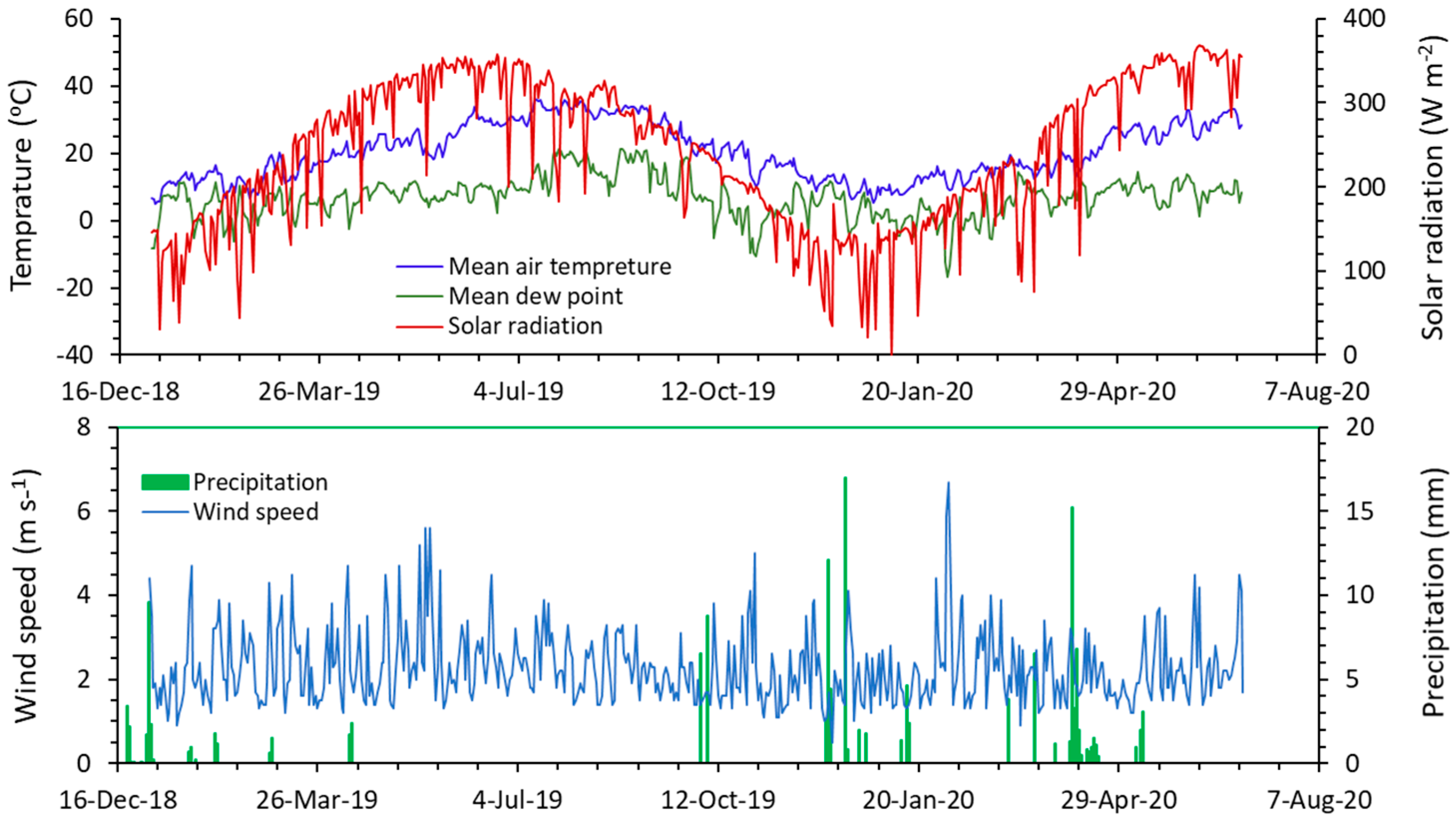
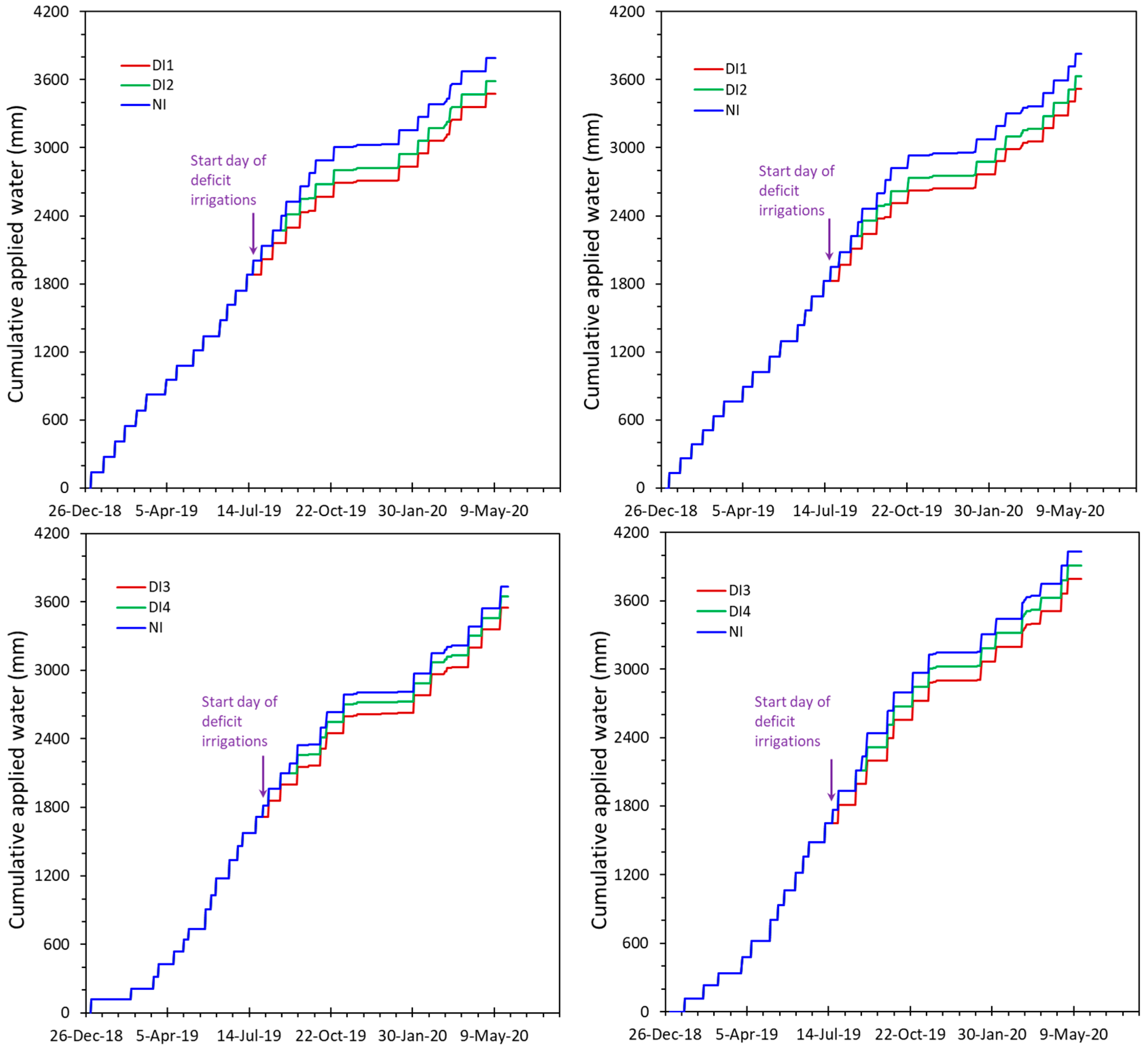
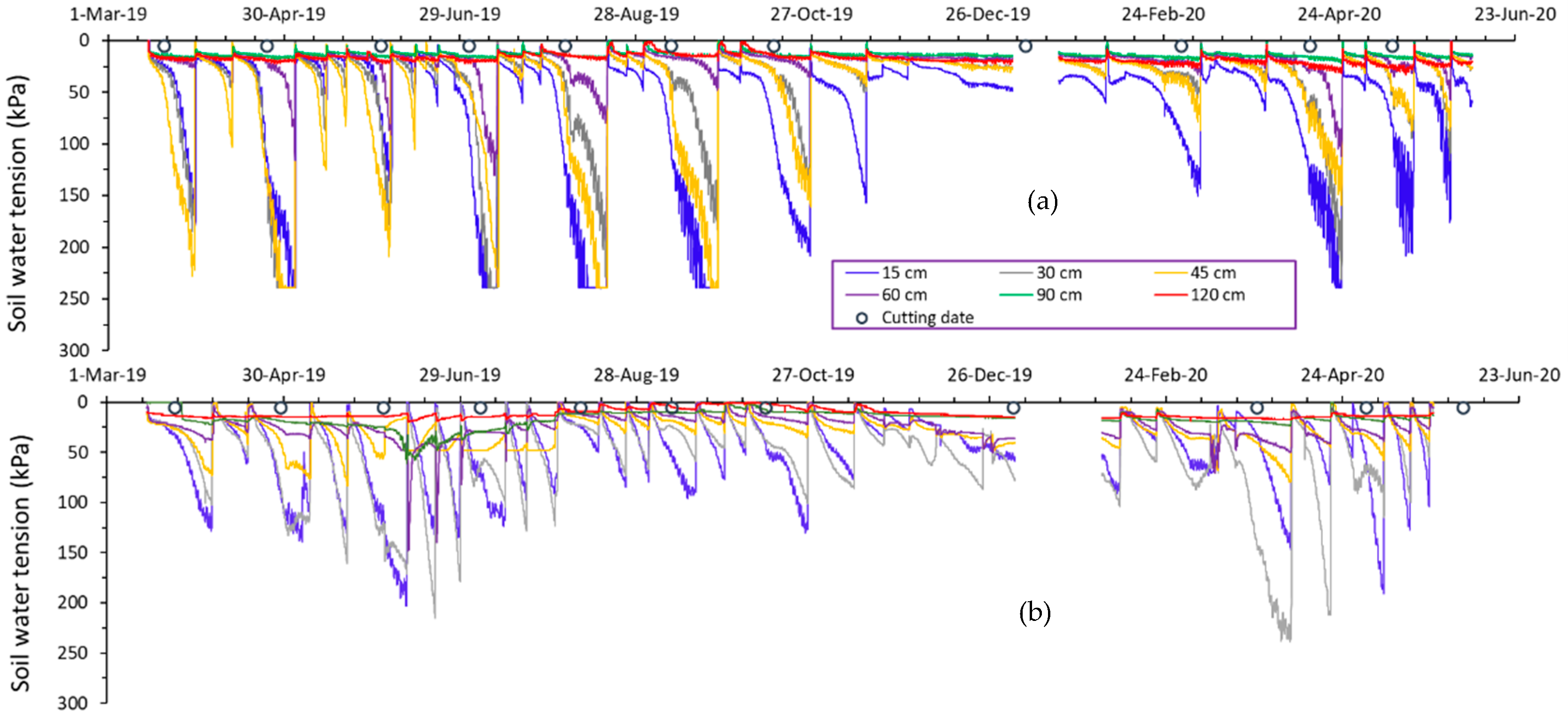
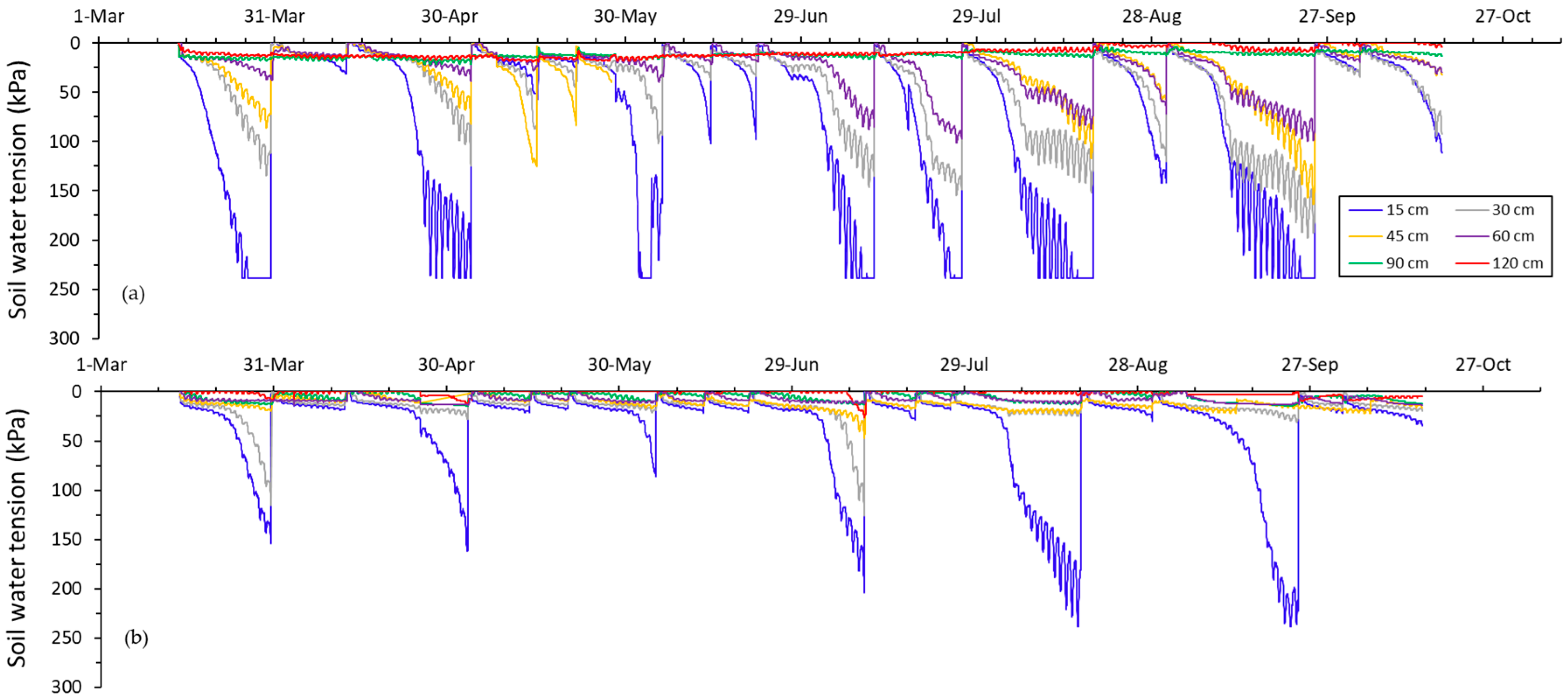

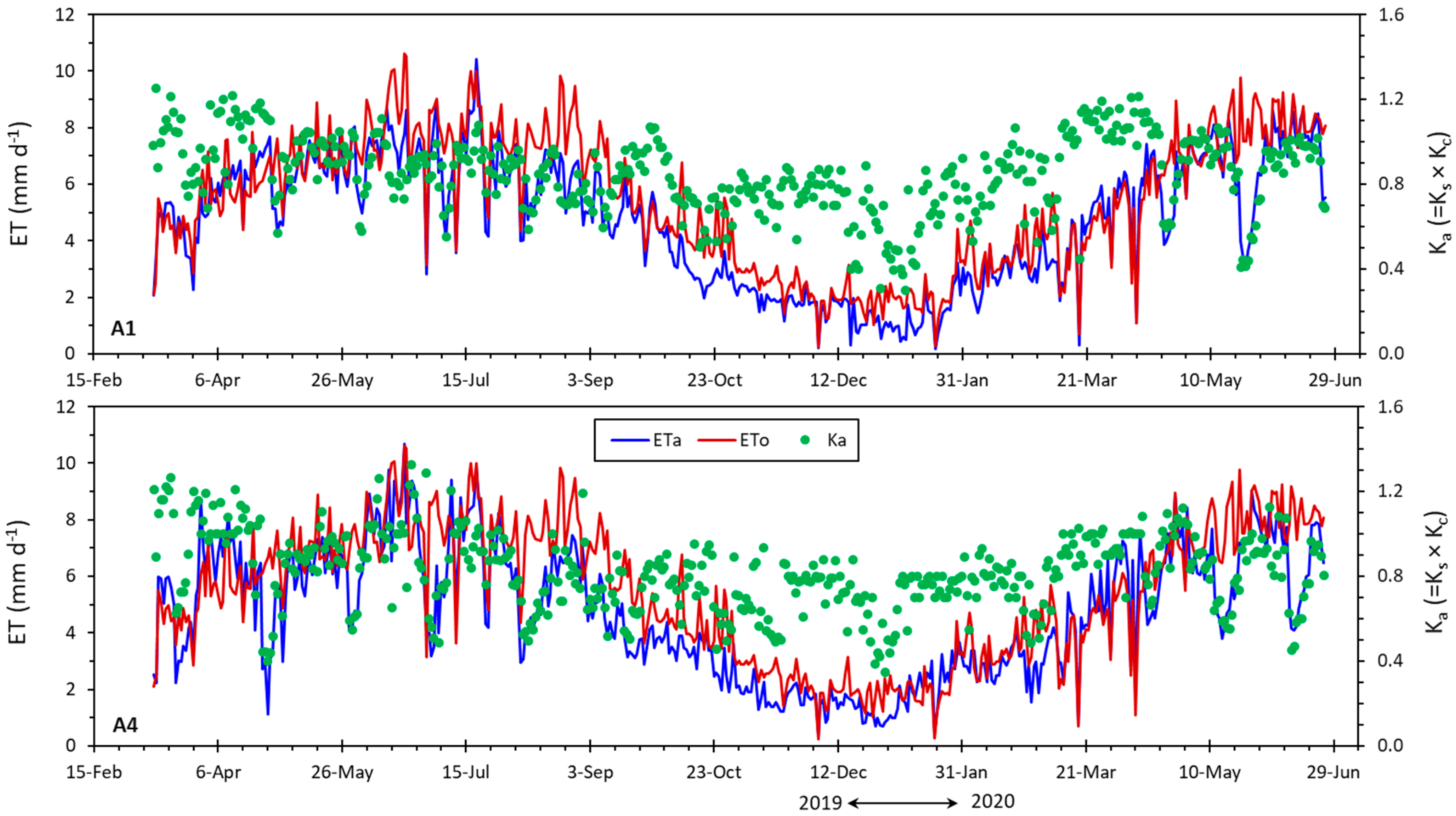
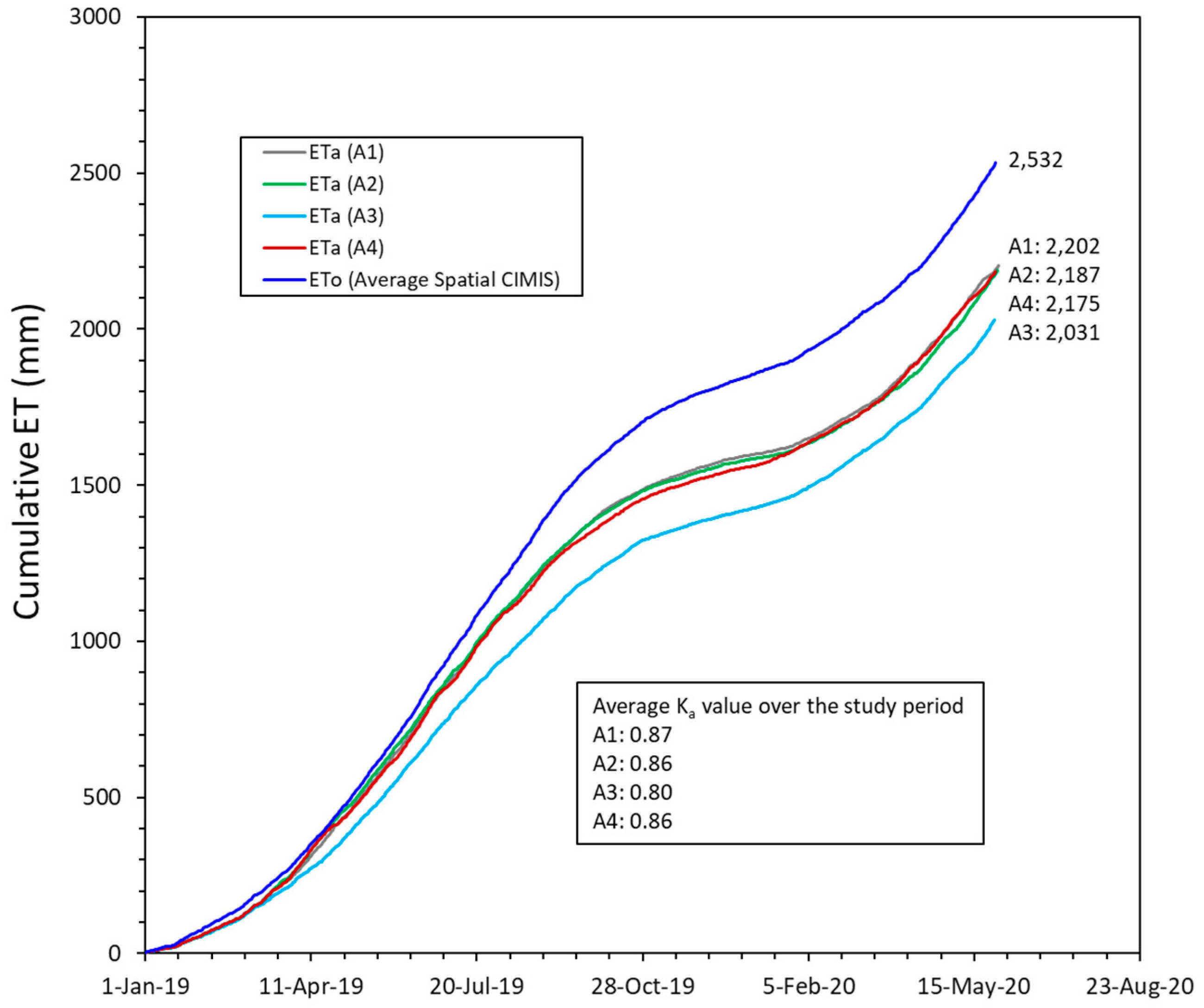
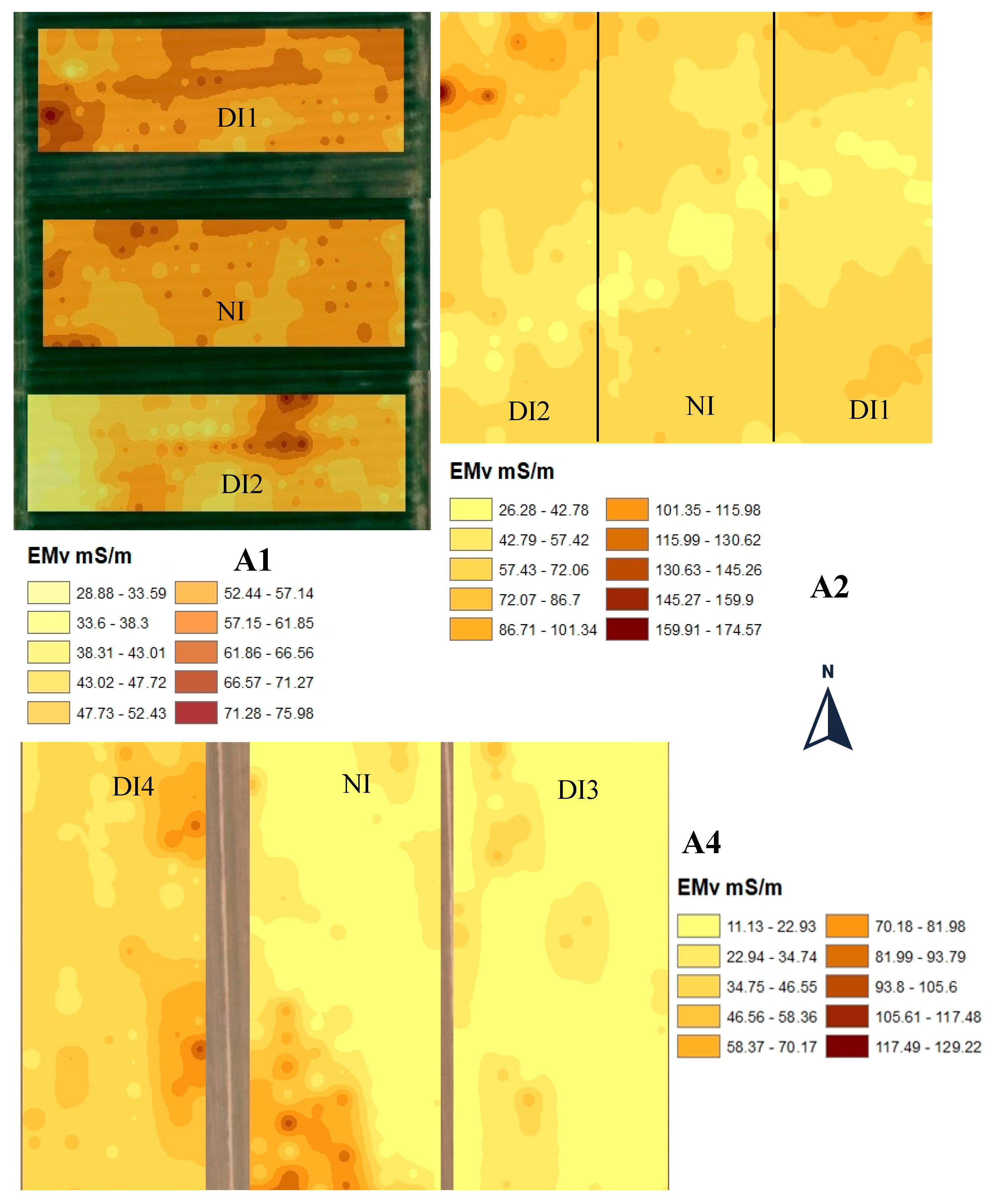
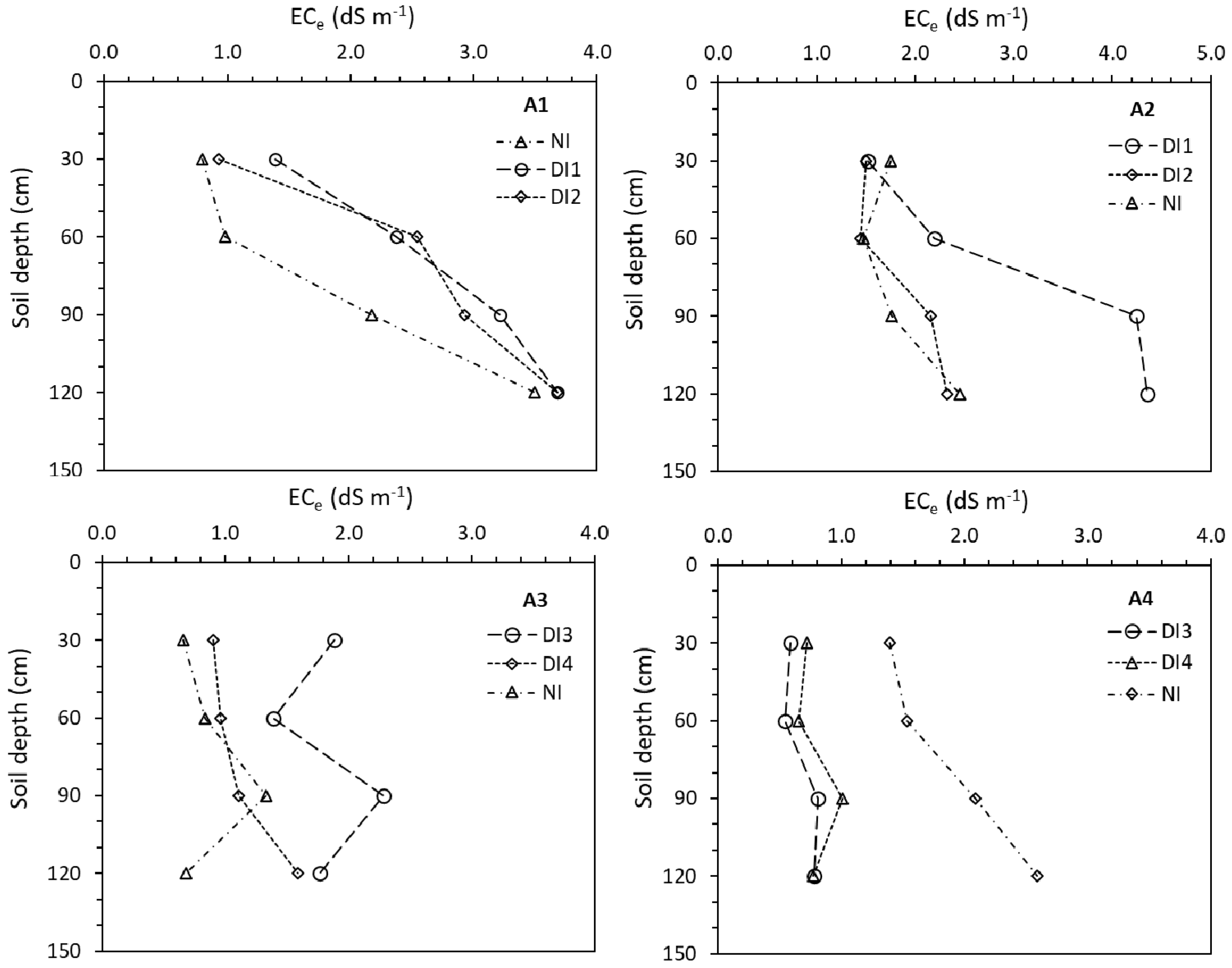
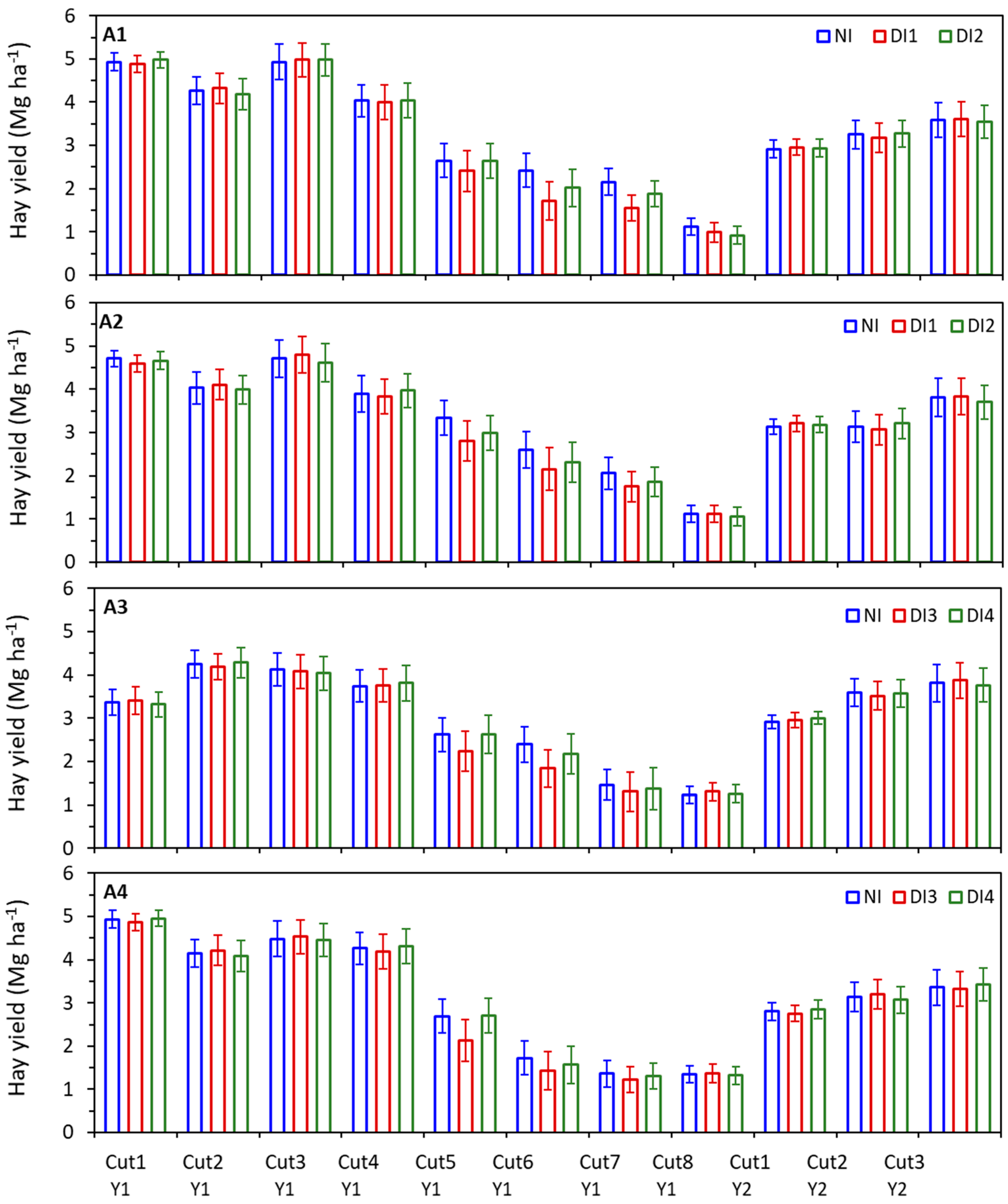
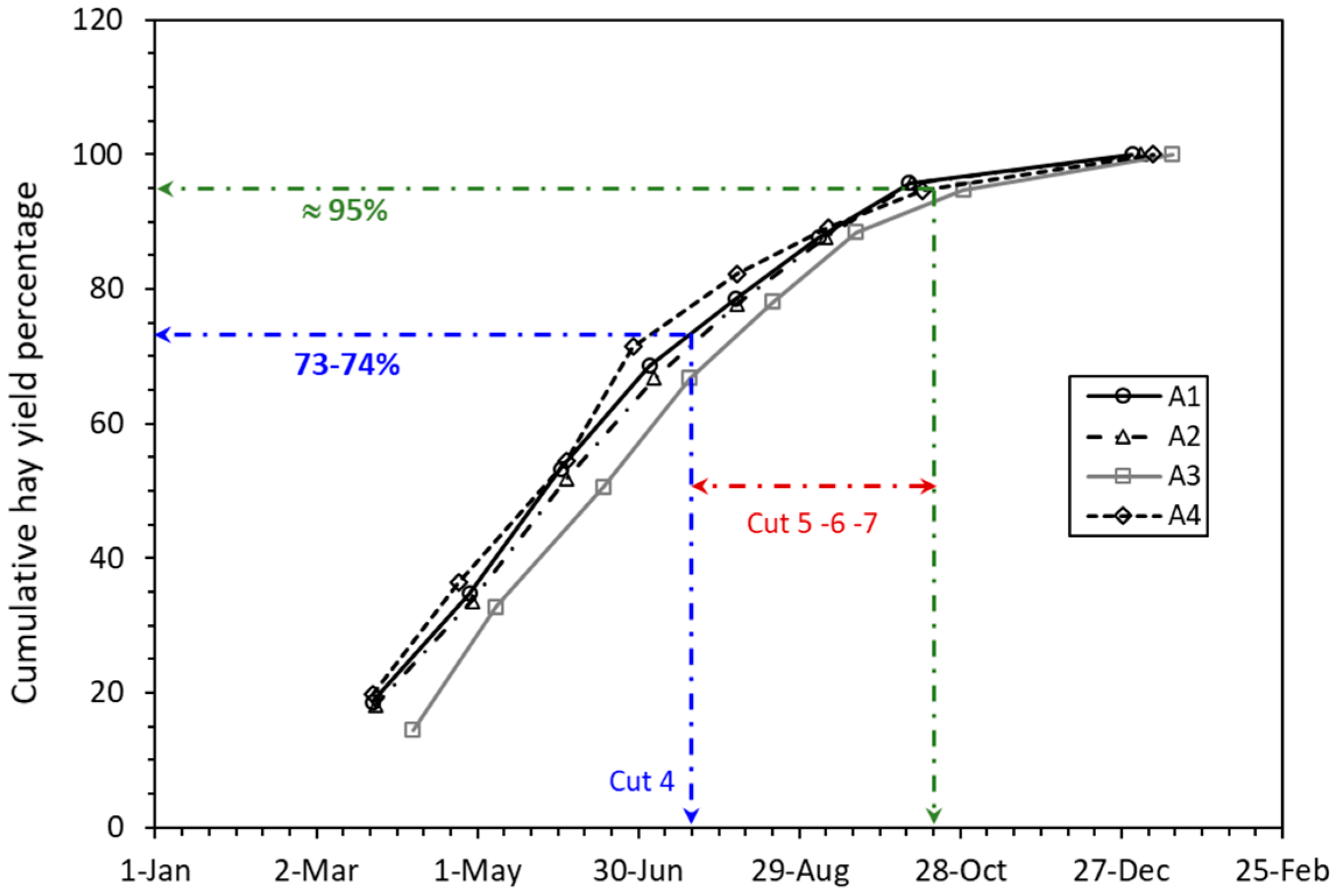
| Month | Rain (mm) | Solar Radiation (W m−2) | Average Air Temp. (°C) | Average Dew Point Temp. (°C) | Average Wind Speed (m s−1) | Total ETo (mm) |
|---|---|---|---|---|---|---|
| Jan | 13.4 | 126.4 | 11.1 | 2.8 | 2.1 | 65.2 |
| Feb | 10.2 | 171.9 | 13.5 | 4.2 | 2.2 | 86.2 |
| Mar | 6.4 | 228.8 | 17.5 | 5.4 | 2.4 | 144.0 |
| Apr | 1.3 | 282.3 | 21.0 | 5.8 | 2.8 | 188.7 |
| May | 2.3 | 322.3 | 24.3 | 8.8 | 2.7 | 227.5 |
| Jun | 0.0 | 331.2 | 29.4 | 13.6 | 2.3 | 232.4 |
| Jul | 8.3 | 295.0 | 32.3 | 19.5 | 2.3 | 221.5 |
| Aug | 9.0 | 275.7 | 32.1 | 20.0 | 2.2 | 202.4 |
| Sep | 5.6 | 232.0 | 28.4 | 17.1 | 2.0 | 157.8 |
| Oct | 6.0 | 186.9 | 22.0 | 11.2 | 1.9 | 122.9 |
| Nov | 3.2 | 140.9 | 14.9 | 5.4 | 1.9 | 76.3 |
| Dec | 12.5 | 111.7 | 10.5 | 2.7 | 2.0 | 58.0 |
| Experimental Site | Generic Horizon (m) | Soil Texture | Organic Matter (%) | CEC (meq/100 g) | pH | ||
|---|---|---|---|---|---|---|---|
| Sand (%) | Clay (%) | Silt (%) | |||||
| A1 | 0–0.3 | 44.2 | 11.1 | 44.7 | 1.7 | 20.6 | 8.0 |
| 0.3–0.6 | 46.9 | 8.1 | 45.0 | 0.8 | 17.4 | 8.1 | |
| 0.6–0.9 | 41.7 | 7.7 | 50.5 | 0.9 | 18.6 | 8.2 | |
| 0.9–1.2 | 47.8 | 5.9 | 46.3 | 0.7 | 16.3 | 8.2 | |
| A2 | 0–0.3 | 39.7 | 20.6 | 39.7 | 2.3 | 22.4 | 8.1 |
| 0.3–0.6 | 50.1 | 11.9 | 37.9 | 0.7 | 14.1 | 8.0 | |
| 0.6–0.9 | 75.0 | 5.1 | 19.9 | 0.9 | 8.0 | 8.2 | |
| 0.9–1.2 | 83.7 | 4.1 | 12.2 | 0.8 | 7.2 | 8.2 | |
| A3 | 0–0.3 | 31.5 | 13.2 | 55.3 | 1.3 | 18.1 | 8.0 |
| 0.3–0.6 | 26.1 | 18.7 | 55.2 | 0.8 | 22.4 | 8.1 | |
| 0.6–0.9 | 88.6 | 2.8 | 8.6 | 0.5 | 10.1 | 8.2 | |
| 0.9–1.2 | 94.8 | 1.4 | 3.8 | 0.5 | 9.2 | 8.4 | |
| A4 | 0–0.3 | 69.3 | 13.1 | 17.6 | 1.7 | 12.7 | 7.9 |
| 0.3–0.6 | 91.9 | 2.8 | 5.3 | 0.8 | 8.1 | 8.2 | |
| 0.6–0.9 | 82.0 | 8.3 | 9.7 | 1.2 | 8.7 | 8.1 | |
| 0.9–1.2 | 85.9 | 5.7 | 8.4 | 0.9 | 6.4 | 8.3 | |
| Site | Number of Irrigation Events | Description of Irrigation Management Strategies | ||||
|---|---|---|---|---|---|---|
| NI | DI1 | DI2 | DI3 | DI4 | ||
| A1 | 30 | 27 | 28 | - | - | DI1: irrigation events were eliminated 20 July 2019, 23 August 2019, and 26 September 2019 DI2: irrigation events were eliminated 23 August 2019 and 26 September 2019 |
| A2 | 31 | 28 | 29 | - | - | DI1: irrigation events were eliminated 21 July 2019, 24 August 2019, and 26 September 2019 DI2: irrigation events were eliminated 23 August 2019 and 26 September 2019 |
| A3 | 24 | - | - | 22 | 23 | DI3: irrigation events were eliminated 31 July 2019 and 2 September 2019 DI4: irrigation event was eliminated 2 September 2019 |
| A4 | 25 | - | - | 23 | 24 | DI3: irrigation events were eliminated 19 July 2019 and 24 August 2019 DI4: irrigation event was eliminated 24 August 2019 |
| NI: following normal farmer irrigation practice over the study period DI1: 33% less applied water than corresponding NI strategy during selected summer period DI2: 22% less applied water than corresponding NI strategy during selected summer period DI3: 25% less applied water than corresponding NI strategy during selected summer period DI4: 12.5% less applied water than corresponding NI strategy during selected summer period | ||||||
| Cut—Year Number | Harvest Time | Ka | |||
|---|---|---|---|---|---|
| A1 | A2 | A3 | A4 | ||
| Cut 1—Year 1 | 23 Mar–4 Apr | 0.81 (±0.13) | 0.81 (±0.14) | 0.79± (0.16) | 0.80 (±0.14) |
| Cut 2—Year 1 | 24 Apr–8 May | 1.00 (±0.14) | 1.03 (±0.15) | 0.83 (±0.16) | 1.01 (±0.11) |
| Cut 3—Year 1 | 1 Jun–12 Jun | 0.94 (±0.13) | 0.92 (±0.13) | 0.78 (±0.14) | 0.83 (±0.14) |
| Cut 4—Year 1 | 3 Jul–12 Jul | 0.89 (±0.12) | 0.87 (±0.13) | 0.85 (±0.13) | 0.98 (±0.12) |
| Cut 5—Year 1 | 5 Aug–16 Aug | 0.88 (±0.14) | 0.86 (±0.11) | 0.83 (±0.10) | 0.86 (±0.15) |
| Cut 6—Year 1 | 5 Sep–19 Sep | 0.85 (±0.10) | 0.82 (±0.11) | 0.75 (±0.12) | 0.77 (±0.11) |
| Cut 7—Year 1 | 9 Oct–29 Oct | 0.78 (±0.12) | 0.74 (±0.13) | 0.74 (±0.11) | 0.73 (±0.12) |
| Cut 8—Year 1 | 31 Dec–15 Jan | 0.72 (±0.14) | 0.73 (±0.14) | 0.71 (±0.13) | 0.70 (±0.15) |
| Cut 1—Year 2 | 4 Mar–30 Mar | 0.78 (±0.16) | 0.79 (±0.15) | 0.83 (±0.17) | 0.87 (±0.14) |
| Cut 2—Year 2 | 20 Apr–5 May | 1.02 (±0.13) | 0.93 (±0.15) | 0.97 (±0.15) | 0.94 (±0.15) |
| Cut 3—Year 2 | 22 May–14 Jun | 0.90 (±0.14) | 0.89 (±0.13) | 0.90 (±0.12) | 0.90 (±0.12) |
| Average | - | 0.87 (±0.10) | 0.86 (±0.09) | 0.82 (±0.07) | 0.86 (±0.10) |
| Site | ADF (%) | CP (%) | Lignin (%) | ||||||||||||
|---|---|---|---|---|---|---|---|---|---|---|---|---|---|---|---|
| NI | DI1 | DI2 | DI3 | DI4 | NI | DI1 | DI2 | DI3 | DI4 | NI | DI1 | DI2 | DI3 | DI4 | |
| A1 | 29.1 | 28.9 ns | 27.8 * | - | - | 21.0 | 20.7 ns | 20.8 ns | - | - | 5.2 | 5.1 ns | 5.2 ns | - | - |
| A2 | 31.2 | 26.4 * | 28.2 ns | - | - | 19.6 | 22.5 * | 21.2 ns | - | - | 5.2 | 5.1 ns | 5.1 ns | - | - |
| A3 | 27.6 | - | - | 25.7 ns | 27.5 ns | 18.3 | - | - | 19.4 ns | 18.4 ns | 4.5 | - | - | 4.6 ns | 4.7 ns |
| A4 | 31.2 | - | - | 26.5 ns | 30.0 ns | 17.6 | - | - | 20.6 * | 18.3 ns | 5.1 | - | - | 4.9 ns | 5.0 ns |
| Site | Normal Irrigation Practice (NI) | Deficit Irrigation Strategy | |||
|---|---|---|---|---|---|
| DI1 | DI2 | DI3 | DI4 | ||
| A1 | 36.2 | 34.6 * | 35.4 ns | - | - |
| A2 | 36.6 | 35.0 * | 35.5 * | - | - |
| A3 | 33.5 | - | - | 32.6 ns | 33.1 ns |
| A4 | 34.3 | - | - | 33.2 ns | 34.0 ns |
| Site | Irrigation Strategy | IWP (kg ha−1 mm−1) | ETWP (kg ha−1 mm−1) |
|---|---|---|---|
| A1 | NI | 8.9 | 16.6 |
| DI1 | 9.3 | 16.1 | |
| DI2 | 9.3 | 16.4 | |
| A2 | NI | 8.9 | 16.4 |
| DI1 | 9.4 | 16.1 | |
| DI2 | 9.3 | 16.3 | |
| A3 | NI | 8.4 | 16.1 |
| DI3 | 8.6 | 15.8 | |
| DI4 | 8.6 | 16.1 | |
| A4 | NI | 8.0 | 15.9 |
| DI3 | 8.3 | 15.6 | |
| DI4 | 8.2 | 15.9 |
Publisher’s Note: MDPI stays neutral with regard to jurisdictional claims in published maps and institutional affiliations. |
© 2020 by the authors. Licensee MDPI, Basel, Switzerland. This article is an open access article distributed under the terms and conditions of the Creative Commons Attribution (CC BY) license (http://creativecommons.org/licenses/by/4.0/).
Share and Cite
Montazar, A.; Bachie, O.; Corwin, D.; Putnam, D. Feasibility of Moderate Deficit Irrigation as a Water Conservation Tool in California’s Low Desert Alfalfa. Agronomy 2020, 10, 1640. https://doi.org/10.3390/agronomy10111640
Montazar A, Bachie O, Corwin D, Putnam D. Feasibility of Moderate Deficit Irrigation as a Water Conservation Tool in California’s Low Desert Alfalfa. Agronomy. 2020; 10(11):1640. https://doi.org/10.3390/agronomy10111640
Chicago/Turabian StyleMontazar, Ali, Oli Bachie, Dennis Corwin, and Daniel Putnam. 2020. "Feasibility of Moderate Deficit Irrigation as a Water Conservation Tool in California’s Low Desert Alfalfa" Agronomy 10, no. 11: 1640. https://doi.org/10.3390/agronomy10111640
APA StyleMontazar, A., Bachie, O., Corwin, D., & Putnam, D. (2020). Feasibility of Moderate Deficit Irrigation as a Water Conservation Tool in California’s Low Desert Alfalfa. Agronomy, 10(11), 1640. https://doi.org/10.3390/agronomy10111640





